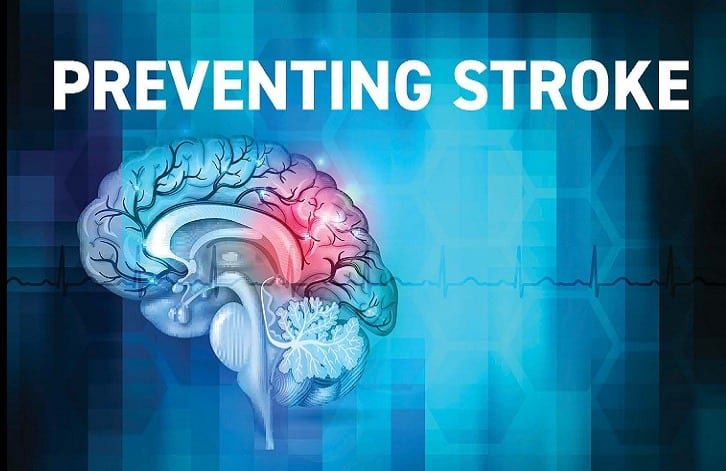
Stoke Prevention Awareness
by Military Health System
WRIGHT PATTERSON AIR FORCE BASE, Ohio — Stroke is the leading cause of serious, long-term adult disability in the United States. The effects of a stroke range from mild to severe and can include paralysis, problems with thinking, difficulty with speaking, and emotional problems.
According to the National Institutes of Health, each year nearly 800,000 Americans experience a new or recurrent stroke. Approximately 610,000 of these are first attacks, and 185,000 are recurrent attacks. Stroke is the fifth leading cause of death in the US, killing nearly 133,000 people a year and accounting for one of every 19 deaths. Nearly three-quarters of all strokes occur in people over the age of 65 and the risk of having stroke more than doubles each decade after the age of 55.
Americans have shown that stroke is preventable and treatable. In recent years, a better understanding of the causes of stroke has helped Americans make lifestyle changes that have cut the stroke death rate nearly in half.
To protect yourself and your loved ones from the serious effects of stroke:
• Learn your risk factors
• Reduce your risk factors
• Learn the warning signs of stroke
• Know what to do if you notice the warning signs
This question and answer guide from NIH explains stroke, stroke causes and symptoms, and how to reduce your risk of a stroke.
What is a stroke?
A stroke occurs when a blood vessel that carries oxygen and nutrients to the brain is either blocked by a clot or bursts. Brain cells in the immediate area begin to die because they stop getting the oxygen and nutrients they need to function.
What causes a stroke?
A blockage of a blood vessel in the brain or neck, called an ischemic stroke, is the most frequent cause of stroke and is responsible for about 80 percent of strokes. When a weakened blood vessel ruptures and spills into brain tissue, it’s called a hemorrhagic stroke. The most common cause for the rupture is uncontrolled hypertension or high blood pressure.
What is a TIA?
A transient ischemic attack is considered a “warning stroke.” A TIA is a type of stroke where the stroke symptoms last only a few minutes and generally stop. A TIA is a serious medical event that needs prompt medical attention.
What are the symptoms of a stroke?
• Sudden numbness or weakness of the face, arm, or leg, especially on one side of the body
• Sudden confusion, trouble speaking or understanding speech
• Sudden trouble seeing in one or both eyes
• Sudden trouble walking, dizziness, loss of balance or coordination
• Sudden severe headache with no known cause
What should you do if a stroke occurs?
If you believe you are having a stroke, or someone you know is having a stroke – Call 911 immediately. Making the decision to call for medical help can make the difference in avoiding a lifelong disability.
How can I reduce my risk of stroke?
Some risk factors for stroke you can’t control such as increasing age, gender, family history and race. The best treatment for stroke is prevention. You can reduce your risk of having a stroke by taking action to improve your health. The following risk factors can be managed with lifestyle changes, such as diet, exercise and medications, if needed:
• High blood pressure or hypertension-High blood pressure is the leading cause of stroke and the most significant controllable risk factor. If you have been diagnosed with high blood pressure, work with your healthcare provider to reduce it.
• Smoking- Cigarette smoking is the number one preventable risk factor for stroke. Using oral contraceptives combined with cigarette smoking greatly increases stroke risk.
• Physical inactivity and obesity- Physical inactivity and obesity can increase your risk of stroke, heart disease, high blood pressure, diabetes and high blood cholesterol.
• Eat healthy- Limit foods high in saturated fat, trans fat and cholesterol. Diets high in sodium can increase blood pressure, and diets with high calories can lead to obesity.
• Diabetes-If you have Type 1 or Type 2 diabetes, keep blood sugar controlled. Having diabetes increases one’s risk for stroke.
• Illegal drug use- cocaine and heroin use have been associated with an increased risk of stroke.
Where can I learn more about stroke?
Talk to your doctor about your personal risk factors for having a stroke.
Comprehensive information about stroke prevention and treatment can be found on the National Institute of Neurological Disorders and Stroke website.

Carol graduated from Riverside White Cross School of Nursing in Columbus, Ohio and received her diploma as a registered nurse. She attended Bowling Green State University where she received a Bachelor of Arts Degree in History and Literature. She attended the University of Toledo, College of Nursing, and received a Master’s of Nursing Science Degree as an Educator.
She has traveled extensively, is a photographer, and writes on medical issues. Carol has three children RJ, Katherine, and Stephen – one daughter-in-law; Katie – two granddaughters; Isabella Marianna and Zoe Olivia – and one grandson, Alexander Paul. She also shares her life with her husband Gordon Duff, many cats, and two rescues.
ATTENTION READERS
We See The World From All Sides and Want YOU To Be Fully InformedIn fact, intentional disinformation is a disgraceful scourge in media today. So to assuage any possible errant incorrect information posted herein, we strongly encourage you to seek corroboration from other non-VT sources before forming an educated opinion.
About VT - Policies & Disclosures - Comment Policy



